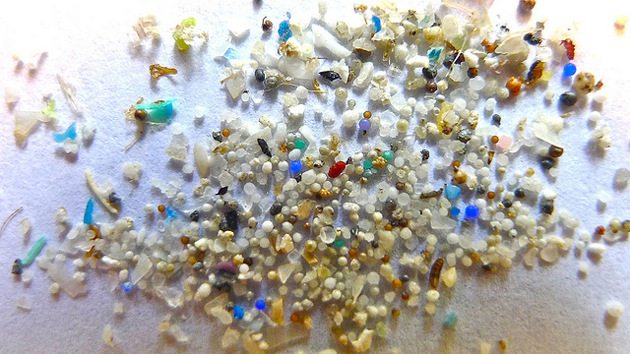Microbeads: small plastics causing big problems
Microbeads have been hitting the headlines recently with calls for a UK-wide ban from MPs, scientists and the public. But what exactly are microbeads, and why are they causing such a fuss?

Microbeads are tiny plastic beads falling into the umbrella term ‘microplastics’; simply put, microplastics are very small pieces of plastic, typically less than 5mm in diameter. Microbeads are added for their abrasive properties to a range of products, labelled as polyethylene (PE), polypropylene (PP), polyethylene terephthalate (PET), polytetrafluorethylene (PTFE) or polymethylmethacrylate (PMMA) on the ingredients list. These include domestic cleaning products, and personal care products such as facial scrubs and toothpaste. Previously, natural materials such as walnut shell and sea salt were used as exfoliants, but industry has shifted away from this as plastic beads can be manufactured at only a fraction of the cost. While seemingly harmless, microbeads are in fact a reason for concern, causing environmental problems and possibly health implications for us too.
Challenges posed by microbeads
The first challenge is their very small size. Microbeads are so small they pass straight through water filtration systems in treatment plants, and escape into waterways. A single tube of body scrub can contain up to 360,000 microbeads, and microbead use is estimated at 8 grams per capita per year in Europe alone. This is the equivalent of several trillions of plastic particles which, when scaled up to take into account global use, amounts to an awful lot of plastic microbeads entering the environment each year. In 2010 alone, an estimated 4.8 – 12.7 million metric tons of plastic entered the ocean.
The second problem lies with the extremely durable nature of plastic. Plastics are manufactured to be strong and hard-wearing, hence their widespread use and versatility. Up to half of all the plastic produced is for single-use products such as food packaging, drinks bottles and microbeads. Once disposed of, plastic takes many decades to break down, leading to widespread accumulation in the natural environment.
Environmental concerns
So why should we be concerned that microplastics are in the world oceans? While larger plastic items are unsightly, microplastics could pose a greater environmental threat, as their small sizes means they can easily be eaten by wildlife. Numerous species have been documented accidentally eating microplastics, and recent reports show up to 90% of seabirds have plastics in their guts. Furthermore, plastics act like sponges, accumulating pollutants which can be adsorbed once in the bodies of animals. The toxicity of microplastics has been demonstrated in laboratory studies: for example, oysters exposed to microplastics have reduced reproduction compared to non-exposed individuals. Another experiment found fish larvae ate microplastics, even preferring them over actual food.
Microplastics entering the human food chain: an ‘emerging concern’
What is also worrying is that once microplastics are ingested by marine life, they might find their way into the human food chain. Recently, the European Food Standard Agency estimated that an average sized portion (225g) of mussels could contain 0.007 milligrams of microplastics. The effects of microplastics on humans is not well researched, but microplastics are recognised to be an ‘emerging concern’ which requires further investigation to establish the exposure levels from various foods, particularly seafood and develop food standard guidelines.
Microbeads have long been an obvious target for reduction, as the addition of plastic to personal care products is completely avoidable, generates redundant emissions and conveys no societal benefits, especially when natural alternatives are available. In 2015, the United States became the first country to pass a microbead ban, and now other countries are following suit. Likely due to the increased global public awareness about the impacts of microbeads, several well-known brands have stated they will be voluntarily phasing out microbeads in the UK by the end of 2017. However, within the last few months the UK government has announced plans to ban microbeads in cosmetics and cleaning products by 2017, with plans for a consultation later this year. Following global pressure, the European Union is also developing proposals to ban plastic beads in cosmetics across the EU.
While there is a long way to go to combat the many millions of tons of plastic debris afloat in the world’s oceans, implementing legislation to remove superfluous sources of microplastics provide easy solutions and can only be steps in the right direction. Similarly, the 5 pence levy on carrier bags in the UK and Ireland has reduced use by 80%.
So where could the next policy focus be?
The UK uses 2.5 million non-recyclable plastic-coated take-away coffee cups annually, and tackling this source of waste along with other takeaway packaging could provide another easy waste reduction solution. Less publicised sources of microplastic pollution are small fibres lost from synthetic clothing in washing machines; however alternative materials and technologies are not readily available. When the easy wins have proved to be not that easy, the harder ones will need far more work.
For more information on the life-cycle of the microbead, check out this great video from the Story of Stuff.
Like what we stand for?
Support our mission and help develop the next generation of ecologists by donating to the British Ecological Society.